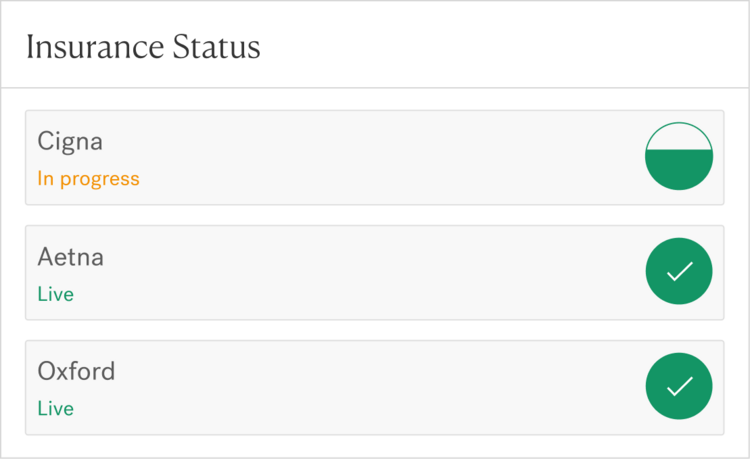About Headway
Getting started with Headway in 30 days

If the journey of one thousand miles begins with a single step, then the journey to starting or streamlining your insurance practice begins with a single call.
When you request a call with Headway, you’re matched with a practice consultant whose number one goal is to make getting started with Headway as simple and pain-free as possible.
“I want you to feel like you now have a partner, and you’re not alone in this whole process of getting up and running,” says practice consultant Alex Hughes.
From your initial call, to getting credentialed and ready to roll, read on to learn more about how easy — and fast — it can be to get started with Headway. You could be seeing patients in a matter of weeks.
1. Talk to a Headway practice consultant, 30 minutes
In your first 30 minutes together, your consultant will answer any questions you have about working with Headway or starting a private practice in general. But the most important part is getting to know you.
“I try to uncover everything I can about the current state of your practice and your goals for your practice going forward,” Alex says. “Whether you have never been in private practice before, or you’ve been in private practice accepting insurance for 30 years."
For those seasoned providers in the latter camp, your consultant can share and compare rates, or walk you through a demo of the Headway tools that make insurance billing — and getting paid — easy. (And after the call, you can skip right to step 5 on this list.)
As for newly licensed practitioners or anyone looking to start their own practice, consultants know that the 30 minute call is sometimes the very first step you’re taking towards working for yourself. In that case, your consultant will help you navigate what’s next — like applying for an NPI number or shopping for malpractice insurance.
“I've worked with over 500 providers,” Alex says, noting that many of them came into the call without any formalities set up, “and I've seen them become successful.”
In the rest of this article, we’ll show you what the next steps look like for those practice starters, but it’s worth repeating: You don’t need to have any of it figured out to get matched with a practice consultant.
“That’s what we’re here for,” says practice consultant Chelsea Dill. “We’re here to help you understand what you need, and help you get it.”
2. Get professional liability insurance, 10 minutes + 24 hours
Professional liability insurance (often called malpractice insurance) is a must-have for private practice, as it protects you against claims of negligence, misconduct, or breach of contract.
If you’ve ever bought car or home insurance, shopping for malpractice insurance will be familiar. You can spend as much time as you want considering the types and levels of coverage that are best suited to your situation.
But it is possible to fill out an application online in 10 minutes — Alex recommends CoverWallet — and have coverage within 24 hours.
“Their malpractice insurance is used by a lot of our providers, costs about $300 a year and includes instructions on exactly how to set it up,” he says. “You can purchase it today and have it back by the end of the day.”
3. Apply for an NPI number, 15 minutes + 10 days
Every provider is required to have a National Provider Identifier (NPI) number in order to send health information electronically. If you’ve practiced with a provisional license, or in a group practice setting, you likely already have a 10-digit NPI number; it doesn’t ever expire or change.
You can search NPI records through the U.S. Department of Health & Human Services website to discover if you have an NPI number.
"If you don't, it's really easy to get one,” says Chelsea. It’s free, and takes around 15 minutes to apply online through the National Plan and Provider Enumeration System (NPPES), and then around 7 to 10 days to receive your NPI number.
4. Create a CAQH account, 30-60 minutes + 2–5 days
If you want to accept insurance in your practice, you’ll first need to establish an account with the Council for Affordable Quality Healthcare (CAQH). It’s free, and takes about 30 minutes to an hour to set up a profile, where you’ll be asked to provide information related to your education, training, and work history.
“It's like the college common application for insurance companies,” says Alex, “whether you work with Headway or someone else.”
Your practice consultant can help you establish a CAQH profile, but it’s a good idea to take a look at the application and get started before your initial call, if you can. The CAQH website shares more specifics about the types of information the profile requires and the materials you’ll want to have nearby for reference, which can help you avoid errors and delays
It takes two days for CAQH to review and approve your account. If errors are found, you may need to re-submit your account for review. But your Headway consultant will be with you every step of the way.
“In two days it should be tested and approved, and I'll reach out to you at that point to confirm and then we can move forward,” Alex says. “I always try to make sure that you know that there's a clear next step ahead.”
5. Complete the Headway Intake form, 30 minutes
With your core requirements in hand — license, malpractice insurance, NPI, and CAQH account — you’re ready to complete our intake form.
“It's an online application that takes about 30 minutes to complete,” Chelsea says. “And it's where we collect the information that we need to get you credentialed.”

That information includes details about your professional history from the last five years, which helps Headway get you credentialed as quickly as possible with the top plans in your state.
“It’s kind of like a job application,” says Chelsea. “You're asked to enter what you’ve been doing for the last five years. And if that's school, that's great too.”
Once you’ve hit submit, congratulations! You’ll now have full access to Headway’s provider portal, and you’re on your way to designing the practice of your dreams.
Welcome to Headway! What happens next?
Our credentialing team will be hard at work getting you credentialed with plans in your state, while you work one-on-one with your consultant to build your practice.
Credentialing timelines vary between state plans and national payer partners, but you could be seeing patients in a matter of weeks. And you'll be able to track your credentialing status at any time with Headway’s provider portal.

In the meantime, your practice consultant can share tips for marketing yourself, finding new clients, and building your ideal caseload (whether your goal is part- or full-time practice). Look out for short follow-up calls, invitations to onboarding sessions, and plenty of self-serve materials to help you design your practice from the ground up.
Hitting submit on the intake form really opens up a new chapter in your career — and a new relationship with your consultant.
“It’s a very celebratory moment,” says practice consultant Amanda Bodhaine. “Whether you're branching out for the first time in private practice and taking that leap of faith, or you're at a different point in your career, we're excited to partner with you and get you ready for that first appointment.”
Recommendations for products and services are provided by practice consultants and real providers like you, and should not be taken as a formal endorsement from Headway. We’ll always disclose affiliations between Headway and other organizations or brands when they’re mentioned.